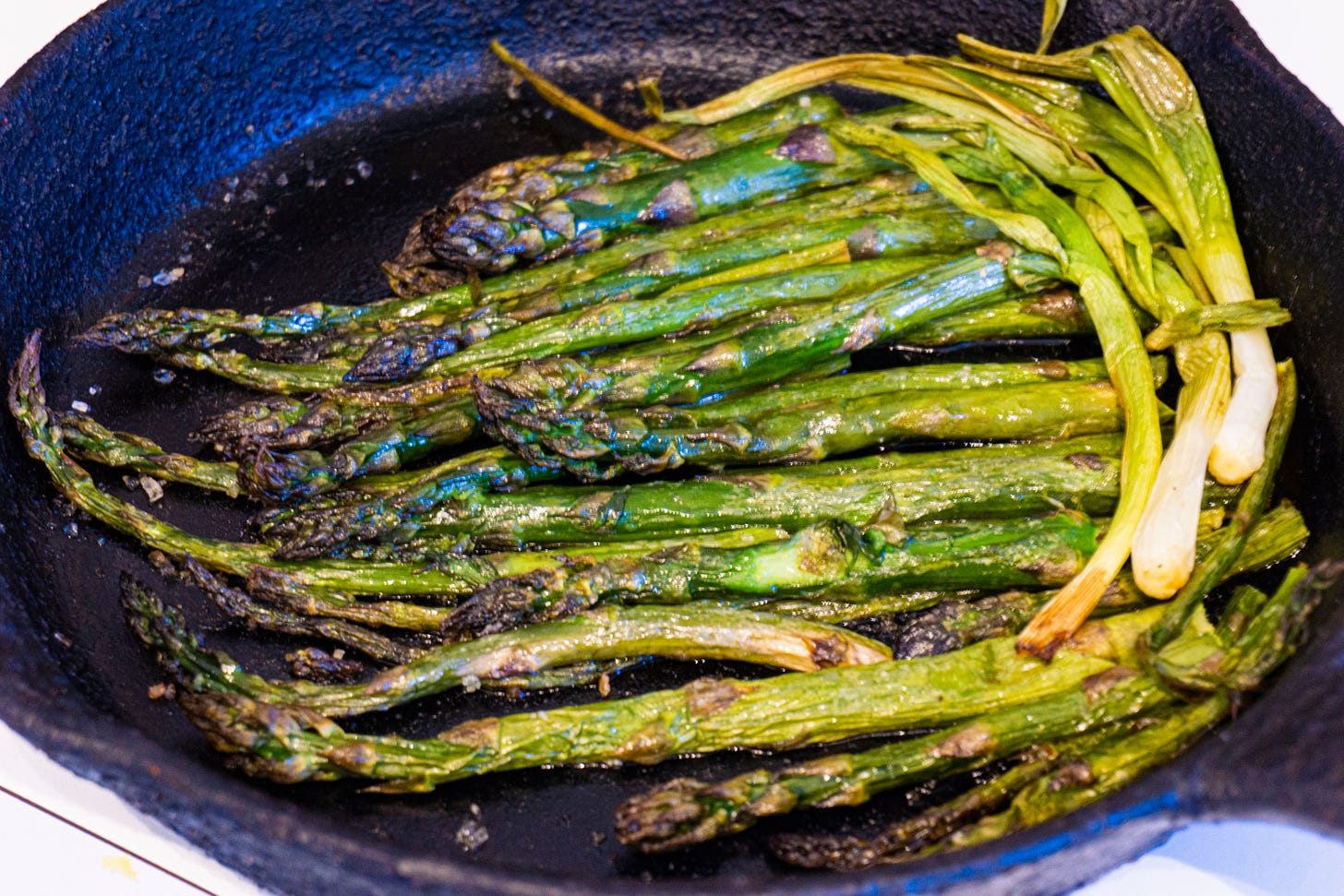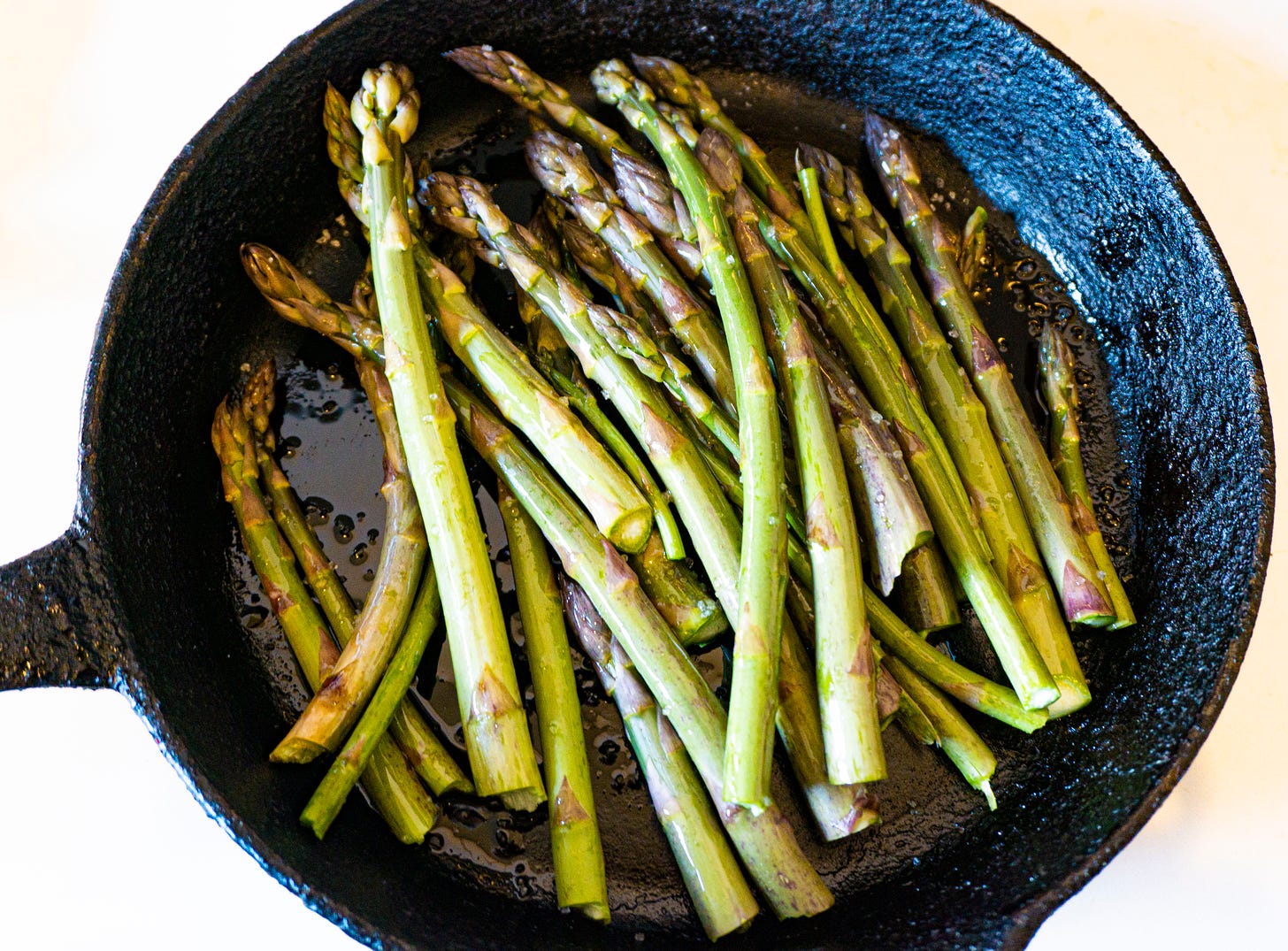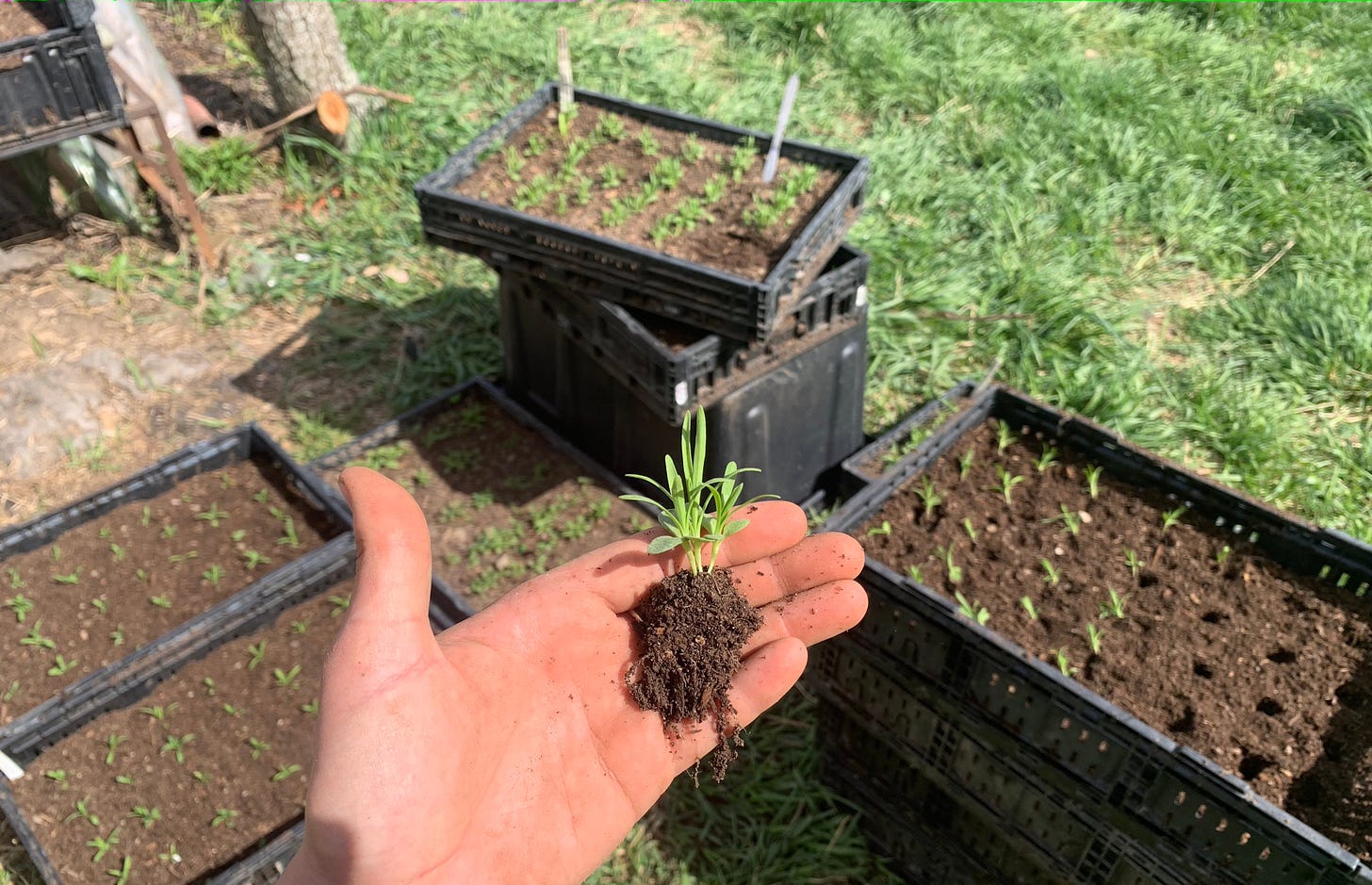The Easiest Delicious Thing to Cook?
Plus, Learning Curve on Wild Trillium Farm & a New Uptown Market
In This Issue
• Roasted Asparagus: The Easiest Delicious Dish?
• Learning Curve: A Wild Trillium Farm Seasons of Change Story
• A Farmers Market and All That Jazz in Uptown
• Take a Quiz
Roasted Asparagus: The Easiest Delicious Dish?
OK, in yesterday’s Local Food Forum, I gushed about getting my first local asparagus of the season from my friends at Michigan’s Ellis Family Farms. Of course I couldn’t wait to dig into it, so I am sharing what I believe is one of the easiest delicious dishes you can prepare: roasted asparagus.
There is so little work involved in prepping roasted asparagus. I used a bunch (about one pound) and washed it carefully (making sure to get rid of any grit). This requires no knife skills: simply hold each spear in both hands and apply gentle pressure until the woody bottom end snaps off.* *
Place the whole top spears in a pan and add a splash of olive oil to coat. Sprinkle lightly with salt (and pepper if you like). Place in a preheated 375 degree oven. The timing is the only trick here: If you want the spears just cooked through, go with 15 minutes. If you want a little brown on them, go 20. If you want them really brown and crispy (kind of like asparagus fries), go 25. In all cases, check for doneness.
Often I’ll add a little garlic and onion powder during prep, but I have beautiful fresh green onions and green garlic from Illinois’ Three Sisters Garden, so I rinsed and trimmed some and laid it across the spears a few minutes into cooking. It added a little allium flavor plus a nice garnish for the plate.
Do you also love roasted asparagus, or do you have another favorite asparagus recipe you’d like share? If you are a paid subscriber, please use the comments feature.
** Pop quiz: What do you do with those snapped-off woody stems? You put them in the freezer with other food scraps and then use them to make vegetable broth. #fightfoodwaste
Learning Curve: Wild Trillium Farm Seasons of Change
Christine Johnson this year has launched Wild Trillium Farm in Richmond, Illinois, with lifelong friends Katie Szymanski and Emmy May. In her late April contribution to our Seasons of Change series, Christine describes the learning curve in transitioning from growing on tiny urban spaces to a small rural farm.
————————-
This year is certainly a transition for us all. Preparing ourselves for the “new normal” as folks now say, or just accepting that we now live in a brand new world even when we weren’t ready or wanting to change.
For us at the farm, the changes are daily. All three of us are used to smaller spaces, personally and professionally. Myself, growing up with three sisters didn’t leave much space at home or with our parents, who were pulled in many directions.
As growers, the same is true. Learning and growing in an urban setting made space critical in planning. Not one corner or property fence wasted, walking paths were measured by averaging the hip width of me and my business partner (and not out of vanity!). Growing in community gardens, with small squares making up the quilt of a one-lot-garden. Starting exactly the number of plants it took to feed yourself inside your tiny city apartment, hardening off seedlings on the front porch while waving to neighbors.
Here in Richmond, we are feeling the intensity of the “expanse.” And we are growing only a total of one acre! But comparing to the past, that is 300 percent larger than what we’ve sustained ourselves on for years. It’s a bit intimidating.
This space issue proves to introduce all sorts of challenges: seed purchasing in packs vs. bulk, intercropping vs. monocropping decisions for row planting, what tools we use to seed and plant. HOW TO USE TRACTORS vs. should we use tractors. Trellising needs to grow upwards vs. not needing to grow up because our plants have the space to crawl and thrive.
Touching the seeds, soil and leaves are all part of what has drawn us to agriculture, and seeing these new little spaces open up between us and our food is a silly thing to ponder considering we now sleep on the same property that we farm.
Most recently we are managing our hoophouse space, as it is 75 percent full of starts almost ready to hop into the field. One change we made was transitioning half of our seeding from cell flats to large crates. This decision was spurred by Gary, farm owner/mentor/genius.
It saves us money, avoiding purchasing extra plastic for seed flats and using aged field compost as a seed starting medium. It saves us water, crates having much deeper soil depths and holding onto moisture for intermittent watering as opposed to 2-3x daily in the tropic temps that rise in our hoop. And it also allows us to still touch the plants.
Starting seeds in densely planted rows supports the small seedlings, and then they are transplanted into new crates with space to grow, harden off and get planted in the field.
No need to go into the embarrassing details that encompassed our first day of direct seeding in the field, but if you can imagine two sets of soft city hands forgoing metal implements and pressing individual seeds into the soil with wishes of good luck, you’ll have an accurate picture.
As we learn more about this land and the efficiency of our energy in larger spaces, we are shifting gears into a new version of farming. We are immensely grateful for this space to learn, stretch our limbs and — most importantly — grow more food for you.
A Farmers Market and All That Jazz in Uptown
Some exciting news popped up yesterday: the Uptown neighborhood on Chicago’s North Side is getting its own Wednesday farmers market, and they aren’t wasting any time getting started.
The market is produced by Chicago Market, the community food co-op that is being built out in the historic Gerber Building adjacent to the Wilson CTA Red Line stop. Starting May 5 and running through October, the farmers market will take place on Wednesdays from 2:30 - 7:00 p.m. at the corner of Wilson & Broadway.
Once one of Chicago’s most sparkling entertainment districts — and still home to the legendary jazz club Green Mill — Uptown has gone through some tough times, so the farmers market… and eventually Chicago Market… will be welcome additions.
Vendors will be announced soon, follow Chicago Market’s Facebook page for updates.
Take a Quiz
Closing the loop on the temperature history for May 1, which this year (Saturday) is the official kickoff of the Chicago area farmers market season. The historic average high temperature on May 1 in Chicago is 65 degrees. Over the past 10 years, what was the chilliest high temperature on May 1?
a) 43
b) 47
c) 50
d) 55
Answer: c) The high temp on May 1, 2014 was a nippy 50 degrees; May 1, 2016 topped out at 51. At the other end of the spectrum, the temperature soared to 85 twice, on May 1, 2013 and 2018.
So what is the advance forecast for Saturday? Keep your fingers tightly crossed, because right now it’s partly cloudy with a high of 61, via weather.com. [Note: This being Chicago, the forecast is subject to change at least six times between now and Saturday.]








